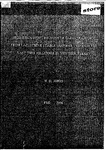HIGH-RESOLUTION RECORDS OF CLIMATE CHANGE FROM LACUSTRINE STABLE ISOTOPES THROUGH THE LAST TWO MILLENNIA IN WESTERN TURKEY
| dc.contributor.author | JONES, MATTHEW DAVID | |
| dc.contributor.other | Faculty of Science and Engineering | en_US |
| dc.date.accessioned | 2012-08-07T10:53:38Z | |
| dc.date.available | 2012-08-07T10:53:38Z | |
| dc.date.issued | 2004 | |
| dc.identifier | Not available | en_US |
| dc.identifier.uri | http://hdl.handle.net/10026.1/1125 | |
| dc.description.abstract |
Knowledge of past chmate variability is vital if the causes of observed chmate changes since instrumental records began are to be fully understood, particularly those, post-1850 AD, possibly due to anthropogenic activity. The past two millennia provide a long enough background with which to compare post-r850 AD change, whilst errors on proxy records remain relatively small. In the Eastem Mediterranean changes in water balance are of particular interest as water is an important resource. Oxygen isotope records from lakes in the region record changes in water balance and are therefore an important archive for observing natural, and anthropogenicaly forced, variabiUty in hydrology. Full understanding of cUmate proxies requires high-resolution analysis through the instramental time period for comparison with measured climate variability. Varved lake sediments provide the possibility for obtaining annually-resolvedarchives of climate proxies, andstrong chronological control through time. In this study gebchemical-climate proxies including oxygen and stable carbon isotope ratios were measured from two lakes in central Turkey with varved sediment archives. Lake Burdur's complex carbonate mineralogy and large catchment led to stable isotope data that is controlled by a variety of mischariisms and highlights the complex nature of some lake-isotope systems. A 1725 year long record was obtained from Nar GolU, with the top 900 years analysed at an annual resolution. Calibration of the top of this record with instmmental cHmate records suggests stable isotope variability at Nar is controlled by changes in evaporation, driven by changes in sunmier temperature and relative humidity. The proxy record from Nar shows sununer evaporation at Nar to be enhanced at times of increased Indian and African monsoon rainfall, and reduced during drier monsoon periods. Major shifts in the chmate system occur c. 500 and c. 1400 AD associated with times of change between relatively warm and cold periods of Northern Hemisphere temperatures. Cycles, with a frequency of 64 years, observed in the Nar isotope record and proxy records of solar activity suggest a solar forcing mechanism for decadal variability in the Eastem Mediterranean-Indian- African sununer climate system. | en_US |
| dc.description.sponsorship | NERC Isotope Geosciences Laboratory, Keyworth, UK; Maden Tetkik ve Arama Genel Mudiirliigu (MTA), Ankara, Turkey | en_US |
| dc.language.iso | en | en_US |
| dc.publisher | University of Plymouth | en_US |
| dc.title | HIGH-RESOLUTION RECORDS OF CLIMATE CHANGE FROM LACUSTRINE STABLE ISOTOPES THROUGH THE LAST TWO MILLENNIA IN WESTERN TURKEY | en_US |
| dc.type | Thesis | |
| plymouth.version | Full version | en_US |
| dc.identifier.doi | http://dx.doi.org/10.24382/4569 |
Files in this item
This item appears in the following Collection(s)
-
01 Research Theses Main Collection
Research Theses Main


